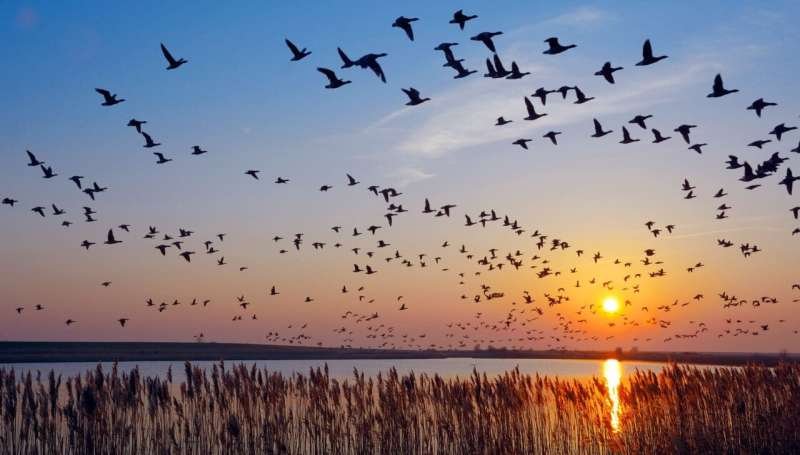
Birds and Light Pollution
Migratory birds are vulnerable to the impacts of artificial light at night. The Big Bend region attracts a highly diverse range of birds, many of which depend on dark environments for survival.
Celestial Guides
The majority of migratory birds migrate at night and use celestial navigation. The stars, moon, sunset or sunrise direction, or other patterns can all be used by birds to help orient themselves. Indigo buntings are one example of a species that uses the sky in this way.
Light pollution can make it more difficult for birds to see the stars and contribute to them becoming lost. The longer a bird is off course or distracted, the more energy it spends on travel and the less time it has at its destination for breeding or feeding. For example, indigo buntings travel many hundreds to thousands of miles each migration season by using the stars as navigational guides, which can take them several weeks and deplete their bodies’ stored fat.
Many birds depend on seasonal cues based on the length of a day to determine when to migrate or nest, but excessive light can cause them to misjudge the season. In some cases birds under light polluted conditions may build nests over a month earlier than birds under dark conditions.
A male indigo bunting.
Attracted to the Light
Skyglow on the horizon from a city can attract or confuse birds.
Many birds are attracted to light sources for reasons which are still poorly understood. Birds can be distracted by the skyglow of cities or industries on the horizon, causing them to fly towards these areas instead of their ordinary route.
Once in developed areas, birds face many additional risks. Birds can be confused by window reflections and illuminated structures, leading to deadly collisions. Bright lights attract birds but make them vulnerable to predators such as owls, hawks, or outdoor cats. Developed areas have fewer opportunities for food and water, increasing the risk of exhaustion and starvation.
Food Chain Disruption
A common nighthawk.
Similar to birds, many insects are confused by light sources. Moths, butterflies, and other insects are strongly attracted to white, blue, and ultraviolet light sources. Many of these insects exhaust themselves to death or overheat under the light, contributing to a larger problem of insect population decline.
Many birds depend strongly on insects as their primary food source. For example, common nighthawks are highly adapted to hunt insects. They can be easily identified by their low, fast, erratic flying pattern on summer evenings. As insect populations decline, common nighthawks struggle to find reliable food sources. Common nighthawks can sometimes be seen near streetlights preying on the attracted moths, but the light also makes them easy prey for larger bird species. Lights can also cause dozens to hundreds of nighthawks to hunt in the same small space and lead to over-hunting.
Darkness Is Cover
Northern saw-whet owls are rare in West Texas, but can be seen in the upper elevations of the Davis Mountains.
While some bird species are attracted to light, others hide from it. Birds such as common poorwills are strictly nocturnal, only emerging under the cover of darkness to hunt for nocturnal insects. During the day they quietly hide from predators under rocks and foliage, aided by their natural camouflage. Northern saw-whet owls are even more wary of light: Even the dim moonlight is enough to keep them from coming into the open, where predators may find them. These are just two examples of ways excessive artificial light can disrupt the balance between predators and prey and alter patterns of behavior.
How You Can Protect Birds
The best way to protect birds from light pollution is to use night-sky friendly lighting practices at your own home or business. These practices ensure light sources are not visible from above and the impact of light is minimized. During peak migration times in spring and fall, you can take additional steps of making sure all outdoor lights are off by 11pm and making sure your blinds or curtains are closed at night. You can learn more about lighting and birds, and even track bird migrations in real time at BirdCast.info.
You can further help birds by providing a good source of drinking water during migration season and preserving native vegetation. Migratory birds in the Trans-Pecos and Chihuahuan Desert have few sources of water to choose from and depend on grasslands, brush, agave, and other plants for shelter or food. Native vegetation is highly important not only for birds, but the insects that they rely on for food. Consider planting native grasses, flowers, and trees in your yard.
During the daytime, reflections from large windows often confuse birds and lead to fatal collisions. You can reduce the risk by installing screens over windows to soften the impact, using large window stickers to make the transparent surface more identifiable, or designing the structure with overhangs to keep direct sunlight off of the windows and reduce reflections.





